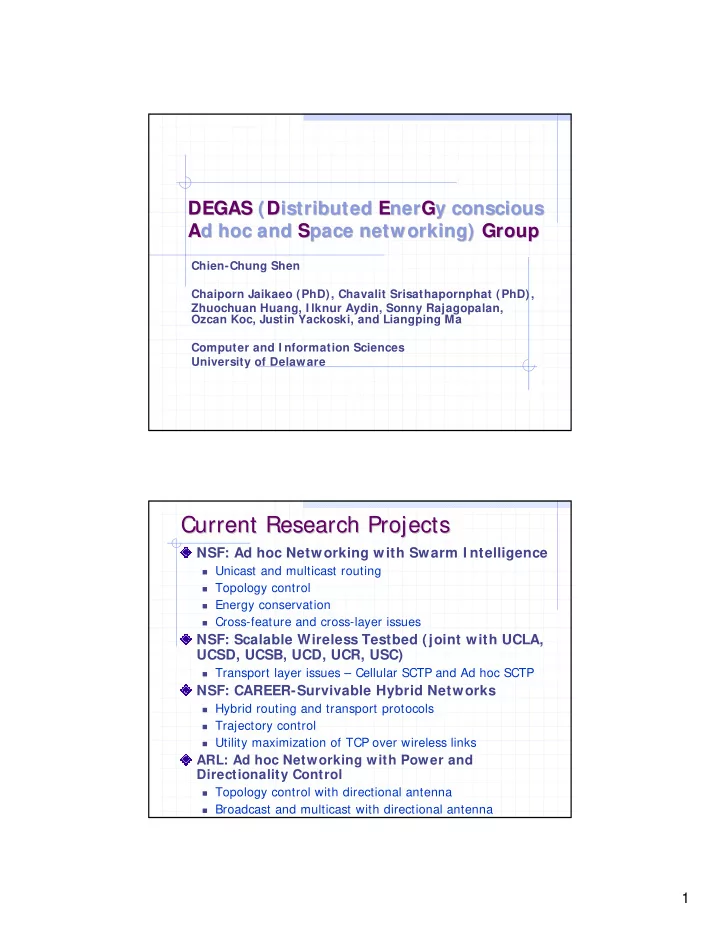

DEGAS ( ( D Distributed istributed E Ener nerG Gy y conscious conscious DEGAS Ad hoc and d hoc and S Space networking) pace networking) Group Group A Chien-Chung Shen Chaiporn Jaikaeo (PhD), Chavalit Srisathapornphat (PhD), Zhuochuan Huang, I lknur Aydin, Sonny Rajagopalan, Ozcan Koc, Justin Yackoski, and Liangping Ma Computer and I nformation Sciences University of Delaware Current Research Projects Current Research Projects NSF: Ad hoc Networking with Swarm I ntelligence � Unicast and multicast routing � Topology control � Energy conservation � Cross-feature and cross-layer issues NSF: Scalable Wireless Testbed (joint with UCLA, UCSD, UCSB, UCD, UCR, USC) � Transport layer issues – Cellular SCTP and Ad hoc SCTP NSF: CAREER-Survivable Hybrid Networks � Hybrid routing and transport protocols � Trajectory control � Utility maximization of TCP over wireless links ARL: Ad hoc Networking with Power and Directionality Control � Topology control with directional antenna � Broadcast and multicast with directional antenna 1
Swarm Intelligence Swarm Intelligence • Ants likely choose Without reinforcement, paths with higher pheromone evaporates pheromone intensity (negative feedback) • Trail gets reinforced (positive feedback) Ants lay pheromone skip Swarm Intelligence Swarm Intelligence But some may choose alternate But some may choose alternate paths with small probability paths with small probability (amplification of fluctuation) (amplification of fluctuation) Most ants follow trail Most ants follow trail with highest intensity with highest intensity Pheromone Trail skip 2
Essence of Swarm Intelligence Essence of Swarm Intelligence Positive and negative feedback � search good solutions and stabilize the results Amplification of fluctuation � discover new solutions and adapt to changing environment Multiple interactions � Allows collaborations among distributed entities to coordinate and self-organize A distributed adaptive control system A d hoc N etworking with SI ( ANSI ) A d hoc N etworking with SI ( ANSI ) Unicast routing (ANSI) Multicast routing ( MANSI ) Topology control ( ABTC ) Energy conservation (ABEC) Feature interactions – cross-layer and cross-feature 3
MANSI MANSI � M ulticast for A d hoc N etworks with S warm I ntelligence MANSI extracts a subset of nodes, called a forwarding set , for m 1 rebroadcasting data packets � Mesh-based, reactive protocol m 3 Issue: A minimum forwarding set is hard to compute m 2 Approach: Use SI-based technique as a heuristic to opportunistically explore and learn new paths that lead to Core forwarding set of lower cost In high mobility areas, more nodes are requested to form a forwarding set to increase reliability Total cost = 4 Ants opportunistically discover Cost = 2 Cost = 1 other paths ABTC: Ant- -Based Topology Control Based Topology Control ABTC: Ant 4
Trajectory Control for MAPs MAPs in MANET in MANET Trajectory Control for Rugged terrains or specific mission requirements can cause a network to be partitioned into isolated islands of nodes Nodes in different partitions still need to communicate � Network Model � Mobile Access Points (MAP) resides in each partition MAPs are highly capable nodes and always connected � via airborne unit(s) in order to bridge partitions together MAPs’ movement can be controlled by a trajectory control algorithm � Trajectory Control Algorithms Trajectory Control Algorithms Location-based (LTC) GPS is required at regular nodes and MAP � Each node maintains a list of its downstream nodes with respect to the � tree generated by MAP announcement Weighted geometric centroid of each subtree is computed recursively � and combined all the way to MAP MAP navigates to the weighted centroid of the entire partition � 5
Future Research Future Research Salutogenic approach to robust P2P systems over mobile ad hoc and wireless sensor networks � Apply biological metaphors to design functional primitives that can be composed to build robust P2P systems over MANET and SN Toward virtual and open spectrum � Dynamic spectrum management architecture and protocols � Software-defined radio 6
Recommend
More recommend